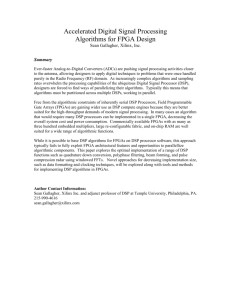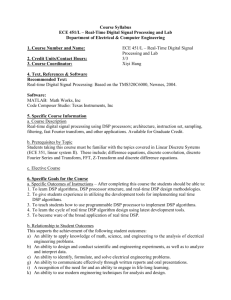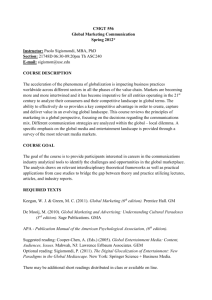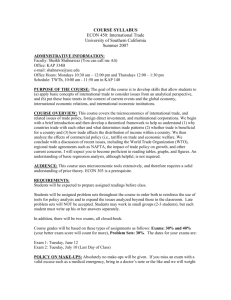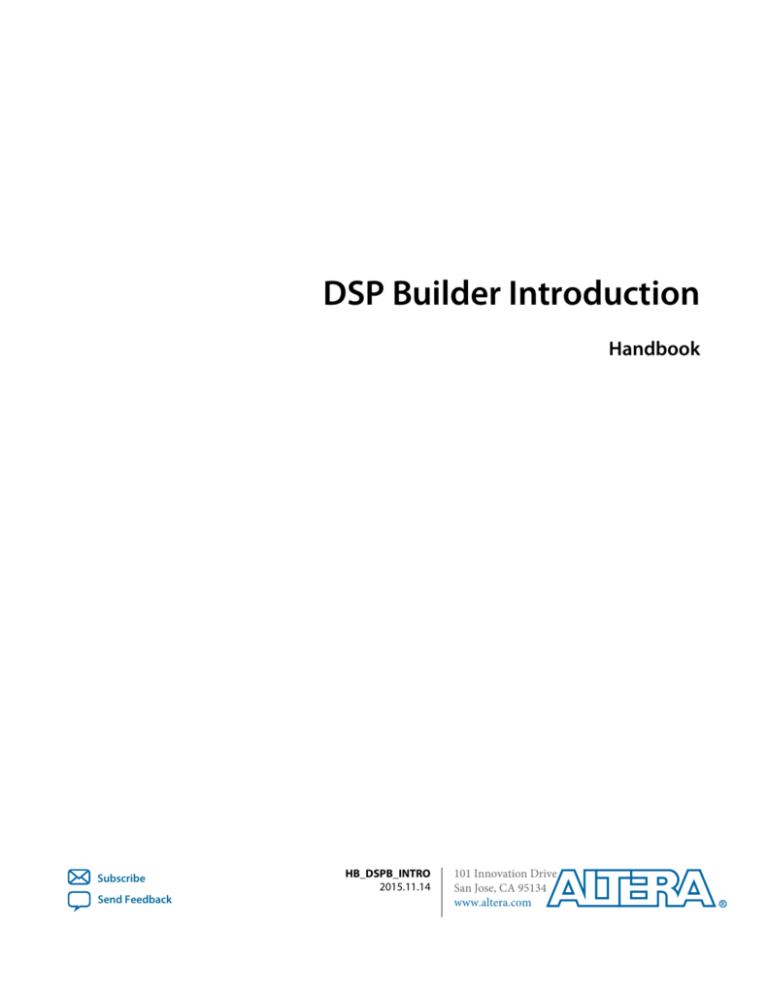
DSP Builder Introduction
Handbook
Subscribe
Send Feedback
HB_DSPB_INTRO
2015.11.14
101 Innovation Drive
San Jose, CA 95134
www.altera.com
TOC-2
Contents
About DSP Design...............................................................................................1-1
FPGA Architecture Features...................................................................................................................... 1-1
DSP Design Flow in FPGAs....................................................................................................................... 1-2
Software and Hardware Design Flows in FPGAs.................................................................................... 1-3
About DSP Builder..............................................................................................2-1
About DSP Builder...................................................................................................................................... 2-1
About the Advanced and Standard Blocksets.......................................................................................... 2-2
Tool Integration........................................................................................................................................... 2-2
Installing DSP Builder........................................................................................ 3-1
System Requirements.................................................................................................................................. 3-1
Installing DSP Builder................................................................................................................................. 3-1
Licensing DSP Builder.................................................................................................................................3-3
Document Revision History................................................................................4-1
Altera Corporation
About DSP Design
1
2015.11.14
HB_DSPB_INTRO
Subscribe
Send Feedback
FPGA Architecture Features
You can configure FPGAs to operate in different modes corresponding to a required functionality. You
can use a suitable hardware description language (HDL) such as VHDL or Verilog HDL to implement any
hardware design. Thus, the same FPGA can implement a DSL router, a DSL modem, a JPEG encoder, a
digital broadcast system, or a backplane switch fabric interface.
High-density FPGAs incorporate embedded silicon features that can implement complete systems inside
an FPGA, creating a system on a programmable chip (SOPC) implementation. Embedded silicon features
such as embedded memory, DSP blocks, and embedded processors are ideally suited for implementing
DSP functions such as finite impulse response (FIR) filters, fast Fourier transforms (FFTs), correlators,
equalizers, encoders, and decoders.
The embedded DSP blocks also provide other functionality such as addition, subtraction, and multiplica‐
tion, which are common arithmetic operations in DSP functions. Altera FPGAs offer much more
multiplier bandwidth than DSP processors, which only offer a limited number of multipliers.
One determining factor of the overall DSP bandwidth is the multiplier bandwidth, therefore the overall
DSP bandwidth of FPGAs can be much higher using FPGAs than with DSP processors.
Many DSP applications use external memory devices to manage large amounts of data processing. The
embedded memory in FPGAs meets these requirements and also eliminates the need for external memory
devices in some cases.
Embedded processors in FPGAs provide overall system integration and flexibility while partitioning the
system between hardware and software. You can implement the system’s software components in the
embedded processors and implement the hardware components in the FPGA's general logic resources.
Altera devices provide a choice between embedded soft core processors and embedded hard core
processors.
You can implement soft core processors such as the Nios®® II embedded processor in FPGAs and add
multiple system peripherals. The Nios II processor supports a user-determinable multi-master bus
architecture that optimizes the bus bandwidth and removes potential bottlenecks found in DSP
processors. You can use multimaster buses to define as many buses and as much performance as needed
for a particular application. Off-the-shelf DSP processors make compromises between size and perform‐
ance when they choose the number of data buses on the chip, potentially limiting performance.
© 2015 Altera Corporation. All rights reserved. ALTERA, ARRIA, CYCLONE, ENPIRION, MAX, MEGACORE, NIOS, QUARTUS and STRATIX words and logos are
trademarks of Altera Corporation and registered in the U.S. Patent and Trademark Office and in other countries. All other words and logos identified as
trademarks or service marks are the property of their respective holders as described at www.altera.com/common/legal.html. Altera warrants performance
of its semiconductor products to current specifications in accordance with Altera's standard warranty, but reserves the right to make changes to any
products and services at any time without notice. Altera assumes no responsibility or liability arising out of the application or use of any information,
product, or service described herein except as expressly agreed to in writing by Altera. Altera customers are advised to obtain the latest version of device
specifications before relying on any published information and before placing orders for products or services.
www.altera.com
101 Innovation Drive, San Jose, CA 95134
ISO
9001:2008
Registered
1-2
HB_DSPB_INTRO
2015.11.14
DSP Design Flow in FPGAs
Soft embedded processors in FPGAs provide access to custom instructions such as the MUL instruction
in Nios II processors that can perform a multiplication operation in two clock cycles using hardware
multipliers. FPGA devices provide a flexible platform to accelerate performance-critical functions in
hardware because of the configurability of the device’s logic resources. DSP processors have predefined
hardware accelerator blocks, but FPGAs can implement hardware accelerators for each application,
allowing the best achievable performance from hardware acceleration. You can implement hardware
accelerator blocks with parameterizable IP functions or from scratch using HDL.
Altera offers many IP cores for DSP design. You can parameterize Altera DSP IP cores for the most
efficient hardware implementation and to provide maximum flexibility. You can easily port the IP to new
FPGA families, leading to higher performance and lower cost. The flexibility of programmable logic and
soft IP cores allows you to quickly adapt your designs to new standards without waiting for long lead
times usually associated with DSP processors.
DSP Design Flow in FPGAs
Traditionally, system engineers use a hardware flow based on a HDL language, such as Verilog HDL or
VHDL, to implement DSP systems in FPGAs. Altera tools such as DSP Builder, enable you to follow a
software-based design flow while targeting FPGAs. DSP Builder simplifies hardware implementation of
DSP functions, provides a system-level verification tool to the system engineer who is not necessarily
familiar with HDL design flow, and allows the system engineer to implement DSP functions in FPGAs
without learning HDL. DSP Builder provides an interface from Simulink directly to the FPGA hardware.
Additionally, you can incorporate the designs created by DSP Builder into a Qsys system for a complete
DSP system implementation .
Figure 1-1: DSP Builder General Design Flow for Altera FPGAs
Use
MATLAB or Simulink to
Design Algorithm
Add Functions
in DSP Builder
DSP
Libraries
Perform Synthesis,
Place-and-Route
(Quartus Prime Software)
Evaluate Hardware
in a DSP
Development Kit
Altera Corporation
About DSP Design
Send Feedback
HB_DSPB_INTRO
2015.11.14
Software and Hardware Design Flows in FPGAs
1-3
Figure 1-2: FPGA-Based DSP Design Flow Options
Software Flow
Software and Hardware
Acceleration Flow
Hardware Flow
* Develop DSP
Algorithm
* Model System
* Develop DSP
Algorithm
* Model System
* Develop DSP
Algorithm
* Model System
Build
System
Use
Software
Library
Develop
Software
Design DSP
Hardware
Accelerator
Functions
Build
System
Configure FPGA
Use
Software
Library
Translate
to HDL
Develop
Software
Configure FPGA
Configure FPGA
Software and Hardware Design Flows in FPGAs
Altera FPGAs with embedded processors support a software-based design flow. Altera provides the Nios
II EDS development tools for compiling, debugging, assembling, and linking software designs. You can
then use either on-chip RAM or an external memory device to download these software designs to an
FPGA.
Embedded processors and hardware acceleration offer the flexibility, performance, and cost effectiveness
in a development flow that is familiar to software developers. You can combine a software design flow
with hardware acceleration. In this flow, you first profile C code and identify the functions that are the
most performance critical. Then, you can use Altera's DSP IP or develop your own custom instructions to
accelerate those tasks in the FPGA. You can run the system control code with the other low-performance
DSP algorithms on a Nios II embedded processor. Altera also provides system integration tools such as
Qsys for system-level partitioning and interconnection. You can use Qsys to build entire hardware
systems by combining the embedded processor, such as a Nios II embedded processor, with other system
peripherals and IP cores.
You can use an HDL-based hardware design flow to develop a pure hardware implementation of a DSP
system. Altera provides a complete set of FPGA development tools including the Quartus® Prime software
and interfaces to other EDA tools such as Synopsys, Synplify, and Precision Synthesis. These tools enable
hardware design, simulation, debug, and in-system verification of the DSP system. You can also follow the
DSP Builder design flow and implement hardware-only DSP systems in FPGAs without learning HDL.
About DSP Design
Send Feedback
Altera Corporation
About DSP Builder
2
2015.11.14
HB_DSPB_INTRO
Subscribe
Send Feedback
About DSP Builder
DSP Builder shortens DSP design cycles by helping you create the hardware representation of a DSP
design in an algorithm-friendly development environment. DSP Builder integrates the algorithm
development, simulation, and verification capabilities of MathWorks MATLAB and Simulink systemlevel design tools with the Altera Quartus Prime software and third-party synthesis and simulation tools.
You can combine Simulink blocks with DSP Builder blocks to verify system level specifications and
perform simulation.
Figure 2-1: DSP Builder System-Level Design Flow
Create System in
MATLAB or Simulink
Run HDL Synthesis
(Quartus Prime Software)
Simulate System
with Testbench
(ModelSim)
Verify System in Hardware
(SignalTap II Logic Analyzer)
© 2015 Altera Corporation. All rights reserved. ALTERA, ARRIA, CYCLONE, ENPIRION, MAX, MEGACORE, NIOS, QUARTUS and STRATIX words and logos are
trademarks of Altera Corporation and registered in the U.S. Patent and Trademark Office and in other countries. All other words and logos identified as
trademarks or service marks are the property of their respective holders as described at www.altera.com/common/legal.html. Altera warrants performance
of its semiconductor products to current specifications in accordance with Altera's standard warranty, but reserves the right to make changes to any
products and services at any time without notice. Altera assumes no responsibility or liability arising out of the application or use of any information,
product, or service described herein except as expressly agreed to in writing by Altera. Altera customers are advised to obtain the latest version of device
specifications before relying on any published information and before placing orders for products or services.
www.altera.com
101 Innovation Drive, San Jose, CA 95134
ISO
9001:2008
Registered
2-2
About the Advanced and Standard Blocksets
HB_DSPB_INTRO
2015.11.14
About the Advanced and Standard Blocksets
The DSP Builder installer installs two separate blocksets (advanced and standard), which you can use
separately or together from the Simulink library browser.
Note: The DSP Builder standard blockset is a legacy product and Altera recommends you do not use it
for new designs, except as a wrapper for advanced blockset designs.
Related Information
• Volume 2: DSP Builder Standard Blockset in the DSP Builder Handbook
• Volume 3: DSP Builder Advanced Blockset in the DSP Builder Handbook
Tool Integration
DSP Builder works with Simulink, the ModelSim simulator, and the Quartus Prime software (including
Qsys).
Simulink
DSP Builder is interoperable with other Simulink blocksets. In particular, you can use the basic Simulink
blockset to create interactive testbenches. The testbench block allows you to generate a VHDL model, so
that you can compare Simulink simulation results with the ModelSim simulator. For information about
Simulink fixed point types, the signal processing blockset and the communications blockset, refer to the
MATLAB Help.
ModelSim Simulator
You can run the ModelSim simulator from within DSP Builder, if the ModelSim executable is in your
path. You can use a script to integrate between the DSP Builder advanced blockset and the ModelSim
simulator. The script runs the automatic testbench flow for a block. It reads some stimulus files at run
time to verify a hardware block. The automatic testbench flow runs a rigorous test and returns a result
whether or not the outputs match.
Quartus Prime Software
The advanced blockset allows you to build high-speed, high-performance DSP datapaths. In most
production designs there is an RTL layer surrounding this datapath to perform interfacing to processors,
high speed I/O, memories, and so on. To complete the design, use Qsys or RTL to assign board level
components. The Quartus Prime software can then complete the synthesis and place-and-route process.
You can automatically load a design into the Quartus Prime software by clicking on the Run Quartus
Prime block in the top-level model.
Qsys
DSP Builder creates a conduit interface and hw.tcl file for each advanced blockset design. It creates a
memory-mapped interface only if the design contains ModelBus blocks or external memory blocks. It can
also create an Avalon® Streaming interface. The hw.tcl file can expose the processor bus for connection in
Qsys. A DSP Builder advanced blockset subsystem is available from the System Contents tab in Qsys after
you add the path to the hw.tcl file to the Qsys IP search path
Altera Corporation
About DSP Builder
Send Feedback
3
Installing DSP Builder
2015.11.14
HB_DSPB_INTRO
Subscribe
Send Feedback
System Requirements
DSP Builder integrates with the The MathWorks MATLAB and Simulink tools and with the Altera
Quartus® Prime software.
Ensure at least one version of The MathWorks MATLAB and Simulink tool is available on your worksta‐
tion before you install DSP Builder. You should use the same version of the Quartus Prime software and
DSP Builder. DSP Builder only supports 64-bit versions of MATLAB.
Table 3-1: DSP Builder Tool Dependencies
Tool
Version
DSP Builder
15.1
15.0
14.1
The MathWorks
(MATLAB and
Simulink)
R2013a
R2013a
R2012b
R2013b
R2013b
R2013a
R2014a
R2014a
R2013b
R2014b
R2014b
R2014a
R2015a
R2015a
R2014b
Note: The DSP Builder advanced blockset uses Simulink fixed-point types for all operations and requires
licensed versions of Simulink Fixed Point. Altera also recommends DSP System Toolbox and the
Communications System Toolbox, which some design examples use.
Related Information
Altera Software Installation and Licensing.
Installing DSP Builder
1. Install DSP Builder from the Altera Complete Design Suite.
© 2015 Altera Corporation. All rights reserved. ALTERA, ARRIA, CYCLONE, ENPIRION, MAX, MEGACORE, NIOS, QUARTUS and STRATIX words and logos are
trademarks of Altera Corporation and registered in the U.S. Patent and Trademark Office and in other countries. All other words and logos identified as
trademarks or service marks are the property of their respective holders as described at www.altera.com/common/legal.html. Altera warrants performance
of its semiconductor products to current specifications in accordance with Altera's standard warranty, but reserves the right to make changes to any
products and services at any time without notice. Altera assumes no responsibility or liability arising out of the application or use of any information,
product, or service described herein except as expressly agreed to in writing by Altera. Altera customers are advised to obtain the latest version of device
specifications before relying on any published information and before placing orders for products or services.
www.altera.com
101 Innovation Drive, San Jose, CA 95134
ISO
9001:2008
Registered
3-2
Installing DSP Builder
HB_DSPB_INTRO
2015.11.14
In the Altera software installer, ensure you turn on DSP Builder in the Select components window.
Figure 3-1: Select Components—DSP Builder
The default installation directory is c:\altera\<version>\quartus on Windows or /opt/altera<version>/
quartus on Linux.
Altera Corporation
Installing DSP Builder
Send Feedback
HB_DSPB_INTRO
2015.11.14
Licensing DSP Builder
3-3
Figure 3-2: DSP Builder Directory Structure
where <path> is the installation directory that contains the Quartus Prime software
<path>
Installation directory containing the Quartus Prime software.
dsp_builder
Contains the DSP Builder standard blockset (legacy).
dspba
Contains the DSP Builder advanced blockset.
backend
Contains back-end files for various IP cores.
blocksets
Contains binary files and MATLAB scripts.
devices
Contains the device specifications.
docs
Contains the Simulink integrated help files.
dspba_cockpit
Contains GUI support files.
examples
Contains the design examples.
libraries
Contains extra HDL libraries.
messages
Contains error messages.
polycache
Contains floating-point support files.
SysConAPI
Contains the API fles.
After installing DSP Builder, the Altera DSP Builder standard blockset and the Altera DSP Builder
advanced blockset libraries are available in the Simulink library browser in the MATLAB software.
Licensing DSP Builder
Before you can use DSP Builder, you must request a license file from the Altera website at and install it on
your computer. The Quartus Prime software recommends you specify a path to an LM_LICENSE_FILE
variable, but it also allows you to use an explicit path to a license file. However, DSP Builder allows you to
specify a path to only an LM_LICENSE_FILE variable.
Related Information
Altera Software Installation and Licensing.
Installing DSP Builder
Send Feedback
Altera Corporation
Document Revision History
4
2015.11.14
HB_DSPB_INTRO
Send Feedback
Subscribe
DSP Builder introduction handbook revision history.
Table 4-1: Document Revision History
Date
Software Version
Changes
2015.11.11
15.1
Updated MATLAB version support for DSP Builder v15.1.
2015.05.01
15.0
Updated MATLAB version support for DSP Builder v15.0.
December
2014
14.1
Updated MATLAB version support for DSP Builder v14.1.
June 2014
14.0
Updated MATLAB version support for DSP Builder v14.0.
November
2013
13.1
Updated MATLAB version support for DSP Builder v13.1.
May 2013
13.0
Updated MATLAB version support for DSP Builder v13.0.
November
2012
12.1
Updated MATLAB version support.
June 2012
12.0
•
•
•
•
•
November
2011
11.1
Updated MATLAB version support.
April 2011
11.0
• Updated MATLAB version support
• Added support for 64-bit MATLAB
• Updated installation instructions
Updated MATLAB version support
Deleted
Upgrading from v7.1 chapter
Updated installation instructions
Updated instructions for starting DSP Builder
© 2015 Altera Corporation. All rights reserved. ALTERA, ARRIA, CYCLONE, ENPIRION, MAX, MEGACORE, NIOS, QUARTUS and STRATIX words and logos are
trademarks of Altera Corporation and registered in the U.S. Patent and Trademark Office and in other countries. All other words and logos identified as
trademarks or service marks are the property of their respective holders as described at www.altera.com/common/legal.html. Altera warrants performance
of its semiconductor products to current specifications in accordance with Altera's standard warranty, but reserves the right to make changes to any
products and services at any time without notice. Altera assumes no responsibility or liability arising out of the application or use of any information,
product, or service described herein except as expressly agreed to in writing by Altera. Altera customers are advised to obtain the latest version of device
specifications before relying on any published information and before placing orders for products or services.
www.altera.com
101 Innovation Drive, San Jose, CA 95134
ISO
9001:2008
Registered



